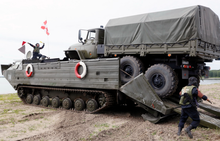| PTS-M | |
|---|---|
 | |
| Overview | |
| Type | Tracked amphibious transport |
| Manufacturer | Lugansk teplovoz LTvZ , Soviet State Factories |
| Production | Begun 1965 |
| Assembly | Soviet Union |
| Body and chassis | |
| Class | Tracked amphibious transport |
| Body style | Waterproofed hull |
| Layout | Front engine (under floor), front drive sprocket[1] |
| Powertrain | |
| Engine | A-712P V12 water-cooled diesel (PTS) or V-54P V12 water-cooled diesel (PTS-M) 250 hp (190 kW) 350 hp (PTS-M) |
| Transmission | Water: PTO propeller drive |
| Range | 300 km (190 mi) |
| Dimensions | |
| Length | 11.52 m (37 ft 10 in)[1] |
| Width | 3.32 m (10 ft 11 in) |
| Height | 2.65 m (8 ft 8 in) |
| Curb weight | 17,700 kg (39,000 lb) |
The PTS is a Soviet tracked amphibious transport. PTS stands for Plavayushchij Transportyer - Sryednyj or medium amphibious transport vehicle. Its industrial index was Ob'yekt 65.
Introduced in 1965,[1] it is large, with a substantial payload of 10 tons, two to four times the capacity of the BAV 485, and better cross-country performance, at the cost of somewhat higher purchase costs because it is tracked. The most common model is the improved PTS-M that is powered by a 350 hp diesel engine.
YouTube Encyclopedic
-
1/5Views:88 99216 77464712 5236 474
-
Tracked Amphibious Transport PTS-2
-
PTS - The Strange Vehicle Being Used By Russia AND Ukraine
-
PTS-4 Amphibious Cargo Vehicle (Russia)
-
Toy Factory + TV + Hybrid Car (165 Points in 55s) FLL SuperPowered: FIRST LEGO League 22-23 Season
-
18th Edition Breakdown - Q16 - Earth Electrodes and Electric Vehicle Charging Points
Transcription
Description
The PTS has a boxy, open watertight hull, with six road wheels per side,[1] front drive sprocket,[1] rear idler sprocket, and no return rollers. Like the BAV 485, and unlike the DUKW, it has a rear loading ramp. The crew is seated at the front, leaving the rear of the vehicle open for a vehicle, which can be driven (or backed) in, rather than lifted over the side. The engine is under the floor.[1] Propulsion in water is by means of twin propellers, in tunnels to protect them from damage during land operations.[1]


The PTS-M also has a companion vehicle, the PKP, a boat-like amphibious two-wheeled trailer, with fold-out sponsons providing stability on water;[1] the combination allows the PTS-M to accommodate an artillery tractor, field gun (up to medium caliber),[1] its crew, and a quantity of ammunition, all in one load.[1]
Specifications
- Top speed: 40 km/h (25 mph) (road)
- Range: 300 km (190 mi)
Variants
- PTS-2
- PTS-3
- PTS-4
In 2014, the Russian Defense Ministry intends to purchase an undetermined number of PTS-4s, which underwent acceptance trials in 2011. The vehicle will be fitted with a remotely operated 12.7 mm (0.50 in) machine gun and a multi-fuel engine. The PTS-4 weighs 33 tons, with a payload of 12 tons on land (18 tons on water). Projected maximum road speed is 60 km/h (37 mph), with an expected maximum speed in water of 15 km/h (9.3 mph).[2] Unlike its predecessors, it uses T-80 suspension components. The fully enclosed cab offers protection against small arms fire and splinter. Production began in 2014.[3]
Users


The PTS-M was adopted by the Soviet Army and Warsaw Pact forces,[1] and has been supplied to Egypt,[1] the former Yugoslavia, Iraq, Uruguay, and other nations.
 Algeria[citation needed]
Algeria[citation needed] Egypt - PTS-M[1] (used during operation Badr)[4]
Egypt - PTS-M[1] (used during operation Badr)[4] Georgia[citation needed]
Georgia[citation needed] Indonesia (Indonesian Marine Corps)[citation needed]
Indonesia (Indonesian Marine Corps)[citation needed] Iraq[citation needed]
Iraq[citation needed] Russia PTS4 OTM UralTM building , PTS 2 PTS3 . PTS1 BTR50 reactivated
Russia PTS4 OTM UralTM building , PTS 2 PTS3 . PTS1 BTR50 reactivated Russian separatist forces in Donbass - PTS-2[5]
Russian separatist forces in Donbass - PTS-2[5] Serbia[6] - 12 PTSM[citation needed]
Serbia[6] - 12 PTSM[citation needed] Sudan[7]
Sudan[7] Syria[citation needed]
Syria[citation needed] Uruguay - 2 PTS in service as of 2016[update][8]
Uruguay - 2 PTS in service as of 2016[update][8] Vietnam[9]
Vietnam[9] Poland - 282 PTS-M [10]
Poland - 282 PTS-M [10] Ukraine - 15[citation needed] PTS-2
Ukraine - 15[citation needed] PTS-2
Former users
 Croatia - 4 PTS-2[citation needed]
Croatia - 4 PTS-2[citation needed] Czech Republic
Czech Republic Czechoslovakia[1]
Czechoslovakia[1] Hungary - 51 PTS-2[citation needed]
Hungary - 51 PTS-2[citation needed] Latvia[citation needed]
Latvia[citation needed] Slovakia[2]
Slovakia[2] Soviet Union - Passed on to successor states:
Soviet Union - Passed on to successor states: Yugoslavia
Yugoslavia Republic of Srpska
Republic of Srpska
See also
References
Notes
- ^ a b c d e f g h i j k l m Hogg, Ian V., and Weeks, John. The Illustrated Encyclopedia of Military Vehicles. (London: Hamblyn Publishing Group, 1980), p.309, "PTS Tracked Amphibian".
- ^ Technical data of PTS-4 in russian http://www.transmash-omsk.ru/node/241
- ^ Russian Defense Ministry to buy new amphibious tracked armoured vehicle PTS-4 in 2014 - Armyrecognition.com, 24 July 2013
- ^ Dunstan, Simon (April 2003). The Yom Kippur War 1973 (2): The Sinai. Campaign 126. Osprey Publishing. p. 19. ISBN 9781841762210.
- ^ The Military Balance 2016, p. 491.
- ^ "Engineering | Serbian Armed Forces". Serbian Armed Forces. Retrieved 14 May 2023.
- ^ "From Conflict to Conflict: Sudan's Fighting Vehicles".
- ^ The Military Balance 2016, p. 414.
- ^ "Vietnam has upgraded PTS-M amphibious vehicle with ZU-23-2 anti-aicraft cannon | weapons defence industry military technology UK | analysis focus army defence military industry army".
- ^ "MON: Następca amfibii PTS powiązany z Borsukiem".
Sources
- Hogg, Ian V., and Weeks, John. The Illustrated Encyclopedia of Military Vehicles, p. 309, "PTS Tracked Amphibian". London: Hamblyn Publishing Group, 1980.
- International Institute for Strategic Studies (February 2016). The Military Balance 2016. Vol. 116. Routlegde. ISBN 9781857438352.
